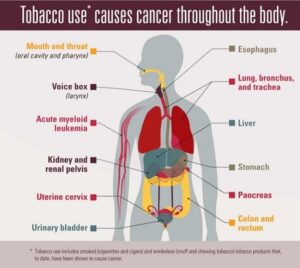(An internal update decided it wanted to save the an older version of this webpage.)
February is Cancer Prevention Month. While there’s multiple things that can cause cancer, this post will highlight smoking’s impact on the disease.


Source: Centers for Disease Control and Prevention (Tobacco and Cancer | CDC)
What is Cancer?1
Cancer is a set of diseases where abnormal cells divide out of control. Cancer cells can spread to other parts of the body via blood and lymph systems (both systems help rid the body of toxins). There are over 100 different types of cancers.
Symptoms include:
- Thickening or lump in any part of the body
- Weight loss or gain with no known reason
- Sore that doesn’t heal
- Hoarseness or cough that doesn’t go away
- Hard time swallowing
- Discomfort after eating
- Changes in bowel or bladder habits
- Unusual bleeding or discharge
- Feeling weak or tired
Source: CDC’s Tips from a Former Smoker, Sharon (Sharon A.’s Story | Real Stories | Tips From Former Smokers | CDC)
Smoking and Cancer2,3
Smoke from cigarettes, cigars, and pipes has at least 70 chemicals that cause cancer. When smoke is breathe in, those chemicals travel throughout the body via the bloodstream. Many of the chemicals damage your DNA, which will then grow differently and could turn into cancer.
Smoking can cause cancer almost anywhere in your body, such as:
- Bladder
- Blood
- Cervix
- Colon and rectum
- Esophagus
- Kidney and renal pelvis
- Liver
- Lungs, bronchi, and trachea,
- Mouth and throat,
- Pancreas
- Stomach
- Voice box (larynx)
Smokeless tobacco can cause the following cancers:
- Esophagus
- Mouth and throat
- Pancreas
Other risks
- Men with prostate cancer who smoke may be more likely to die from it than nonsmokers.
- Secondhand smoke causes lung cancer
- Secondhand smoke causes over 7,300 lung cancer deaths a year in nonsmokers
Tobacco Use Among Cancer Survivors4
Estimates suggest that 9% to 18% of cancer survivors smoke cigarettes. Cancer survivors under 40 are more likely to smoke. Tobacco use can increase the risk for:
- Poorer response or outcomes to treatment
- Have cancer recur
- Developing a new primary cancer
- Dying from a primary or secondary cancer
- Dying from other causes, like pneumonia or another infection
Source: CDC’s Tips from a Former Smoker, Rose (Rose H.’s Story | Real Stories | Tips From Former Smokers | CDC)
Benefits of Quitting
- Quitting lowers the risk for the following cancers:
- Lung
- Mouth
- Throat
- Esophagus
- Larynx
- Within 5 years of quitting, the chance of getting mouth, throat, esophagus, and bladder cancer is cut in half
- 10 years after quitting, the risk of dying from lung cancer drops in half
- Help protect your family, friends, and neighbors from secondhand smoke exposure and its risks
Resources
- SavedByTheScan.Org: current and former smokers can check to see if they’re eligible for lung cancer screening.
- American Cancer Society: check out what the Alaska chapter is doing
- Alaska Quitline: ready to quit? Call 1-800-QUIT-NOW
- Live Vape Free: teen and ready to quit? Text VAPEFREE to 873373
- Multiunit housing and want help with smoking or vaping concerns? Contact the American Lung Association at SmokefreeHousingAK@Lung.Org or 907-931-5470
References



